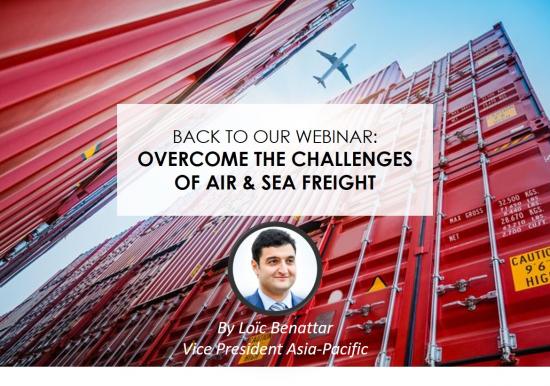The year 2020 brings historic logistical and transportation challenges: almost a year after the emergence of the pandemic, we are experiencing a disruption in the transport market. How can this situation be explained? How to deal with these disruptions.

The year 2020 brings historic logistical and transportation challenges: container shortages, stopover cancellations, short-notice overloads in sea freight and an overall increase in freight rates, then a saturated rail silk road, reduced air freight capacity, all this is coupled with the recurring problems of the high season with the end of year festivities.
Almost a year after the emergence of the pandemic, we are experiencing a disruption in the transport market. How can this situation be explained? How to deal with these disruptions?
To answer these questions, Loïc Benattar, Vice President Asia-Pacific of the Bansard International Group, has been invited by the French Chamber of Commerce in Singapore (FCCS) to lead a webinar, shared his experience via videoconference. Find back here the presentation and following key points, starting with air freight and then sea freight.
In 2020, the number of daily flights worldwide is reduced by almost a half compared to last year. The reasons for this situation consist mainly of the following topics:
- A passenger fleet that remains grounded.
- Covid related crew regulations
- Still very strong demand for PPE & electronic products
- Strong E-commerce activity due to the change in consumption habits
- Lack of capacity in rail and sea freight
- Sep-Dec & Pre-CNY, a traditional period of peak season
- Heavy airport congestions
It remains difficult to forecast the market in 2021, if the pandemic will continue to spread or diminish and its impact on the global economy, passenger transportation regulations, we must be aware that even if the market stabilizes, it will inevitably remain at a higher level than it has been. First of all, the strong demand for PPE (especially for Covid tests) will still not decrease in the following months. The distribution of vaccines will also bring another set of logistical challenges to the market: especially since some of them will have to be stored at a very low temperature and be delivered to the final consumer in less than 5 days. In the meantime, brings more missions to the airlines which are mostly already in unstable financial condition.
~
2020 was a record year, which saw the export price of a 40HC from China to Europe rise from USD 1,500 in May 2020 to USD 10,000 in January 2021. We all witnessed the madness of the maritime market last year. But even with such high prices, we could not benefit from the same level of service standards as the price, which has deteriorated. Data shows that the schedule reliability of carriers has been reduced to 30% as in 2019(source: sea-intelligence maritime analysis – Jan 2021). The reasons cited during this webinar to explain this situation are :
- The growing demand for exports from China, which noted an increase in its exports of +7.2% in July and +21.2 in November, higher than in 2019 has led almost all shipping companies to increase and redirect their fleets to Asia.
- Shortage of containers (blank sailing & cancellations of container orders, resumption of orders, chassis shortage in USA…)
- Traditional peak-season with the end of the year and pre-Chinese New Year
WILL THE PRICE GO DOWN FAST OR NOT?
To answer this question, we have to realize that from now on capacity will decrease according to the market without necessarily experiencing lower prices. Due to the situation of the 3 alliances, the shipping lines have become more agile, they control better their sea freight rates, now they are able to adapt their capacity in 3 weeks when before they used to take 8 to 12 weeks. As a result, the ocean freight market is expected to remain at a higher level than before.
As for the container shortage, it is estimated that it will not yet be at an "acceptable" level in at least 3 months. There will also be a divergence between shipping companies, some have better managed the management of their equipment than others.
Moreover, it is expected that demand will continue to increase from China. It can be observed that the closure of production sites has been minimized during the Chinese New Year. As the government has also drastically limited the movement of people between the different provinces, many workers remain at their production sites. Thus, we believe that most factories and facilities will recover quickly after the CNY.
By consequence, long term deals have been signed at higher levels compared to last year with bcos
If you need further information our team remain at your disposal, do not hesitate to contact us
With its expertise in the world of sea & air freight, Bansard International will always support you with the latest market news, "multi-carrier solutions" approach in order to best meet your needs and offer you the solution that best suits your supply chain and market trend nowadays.



